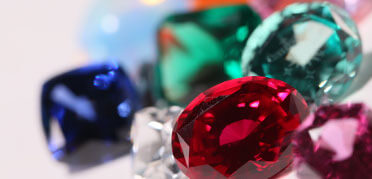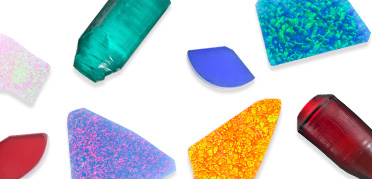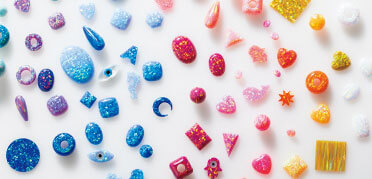Kyoto Opal
A New World of Color
Your Choice of Colors
- 12 Basic Colors -
-
Gofun


Gofun
Gofun, a traditional Japanese color, is white with a slight yellow caste similar to mother of pearl. Since the 14th century, gofun has been made by crushing oyster shells from Japan’s Seto Inland Sea.
Kyoto Opal Gofun achieves a traditional mother of pearl color with majestic brilliance.
-
Kariyasu


Kariyasu
Kariyasu, a traditional Japanese color, is light greenish yellow. The name comes from the kariyasugusa plant used as a yellow dye since the 8th century. This is considered to be the oldest yellow color in existence.
Kyoto Opal Kariyasu is the same bright yellow cherished for centuries.
-
Sakurairo


Sakurairo
Sakura is a Japanese cherry blossom featuring pale, purplish-pink flowers. Iro means color in Japanese. The cherry blossom is the national flower of Japan, where sakurairo is the color of spring.
Kyoto Opal Sakurairo is the pale purplish pink loved by the people of Japan.
-
Jinzamomi


Jinzamomi
Jinzamomi, a traditional Japanese color, is yellowish red. The name comes from the Kikyouya Jinzaburo dye shop in Kyoto. By using sappanwood and madder to replace the more expensive safflower as the red dye ingredient, this dye shop discovered a new dye method and named its new color Jinzamomi. The beautiful color and accessible price of Jinzamomi makes it very popular.
Kyoto Opal Jinzamomi is the bright red color everyone loves.
-
Karakurenai


Karakurenai
Karakurenai, a traditional Japanese color, is a bright dark red. To achieve its intense color saturation, karakurenai cloth was dyed with safflower eight times over.
In ancient times, safflower was expensive and considered forbidden, so only high-ranking aristocrats could wear karakurenai clothing.
Kyoto Opal Karakurenai is the bright dark red once considered a forbidden color.
-
Nijiiro


Nijiiro
Niji is the Japanese word for rainbow, and iro means color.
In Japan, we express the seven colors of a rainbow as red, orange, yellow, green, blue, indigo and purple.
Kyoto Opal Nijiiro seems pink at first glance, but its delicate pink color and brilliant fire erupt in a dazzling array of colors under changing light conditions.
-
Kakitsubatairo


Kakitsubatairo
Kakitsubata is a Japanese plant with a regal purple flower, and iro means color.
Kakitsubata was once used as a dye to produce a grape color similar to red wine. Purple is considered a noble color because the dye ingredient is relatively rare.
Our technology lets the noble purple Kyoto Opal Kakitsubatairo appear on various fashions items around the world.
-
Asagiiro


Asagiiro
Asagi is the light blue-green color of a spring onion, and iro means color.
Its beautiful light blue-green color reminds us that Japan is blessed with abundant water resources. Loved for more than 1,000 years, this traditional Japanese color grew in popularity when the shogun's last samurai corps used it on their fashionable uniforms.
Kyoto Opal Asagiiro is a fresh, light blue-green that reminds us of Japanese nature and history.
-
Tsuyukusairo


Tsuyukusairo
Tsuyukusa is a popular plant with a light blue flower, and iro means color. Tsuyukusa is used in the traditional Yuzen dying technique in Kyoto, and is therefore a culturally significant color in Japan.
Kyoto Opal Tsuyukusairo forms a light blue bridge between the fashion world and Japanese culture.
-
ChitoseMidori


ChitoseMidori
ChitoseMidori, a traditional Japanese color, is dark green like Japanese pine.
The Japanese pine symbolizes longevity because pine trees are evergreen. ChitoseMidori means that the color won’t change, even after 1,000 years.
Kyoto Opal ChitoseMidori captures the immutable beauty of Japanese pine needles.
-
Ruriiro


Ruriiro
Ruri is Japanese for lapis lazuli, and iro means color.
Lapis lazuli is one of the seven treasures in Buddhism, making ruriiro a sacred color.
By fusing the color of lapis lazuli with brilliant fire, Kyoto Opal Ruriiro expresses the brilliance of a fiery night sky.
-
Momoshiocha


Momoshiocha
Momoshiocha is a traditional Japanese color similar to chocolate, but with complex undertones of brown, green and red that give it a brilliant luster.
By fusing the characteristically deep color with brilliant fire, Kyoto Opal Momoshiocha manifests a rich chocolate color of our dreams.
Our Story
Kyocera Corporation, which made Forbes’ list of the World’s Best Regarded Companies in 2019, has developed an innovative synthetic opal impregnated with polymer for added strength.
The company’s Kyoto headquarters inspires the Kyoto Opal colors, which reflect traditional Japanese culture and seasonal beauty.
Expanding Your Design Options
Natural opals are brittle and tend to crack when cut. Kyocera’s opals are engineered for strength so they won’t crack. That means you can cut them into any imaginable shape.
Properties of Kyoto Opal
| Synthetic Colored Opal | |
| Elements | SiO2 ( silica )( 80wt% ) + Resin( 20wt% ) |
| Hardness ( Mohs ) | 4 |
| Specific Gravity | 1.80 - 1.90 |
| Heat Resistance | 130 degree C. |
| Maximum Width x Length | Approx. 50 x 50mm(*) |
| Maximum Thickness | Approx. 15mm |
* Cut from an unfixed form












